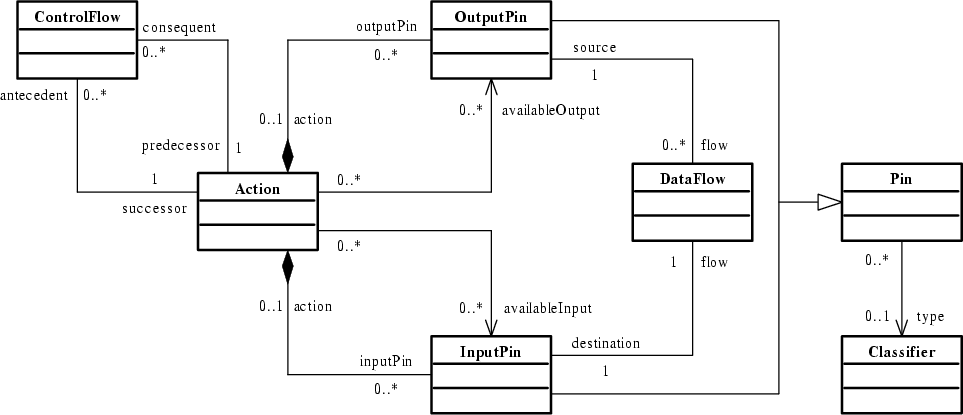


Next: 3.2 Composite actions
Up: 3 Action semantics at
Previous: 3 Action semantics at
Figure 4:
The minimal core of the action semantics package
|
|
Action semantics defines a core package for UML, which serves as the basis of
all kinds of actions. The core consists of a set of fundamental actions and
their semantics, as is illustrated in Figure 4[BB01].
Two kinds of flows control the execution sequence of actions: control flow and
data flow. All actions are treated as executing concurrently except those
sequenced by a data flow or a control flow [AILKC+00].
- Control flow. An action is executed only after all its antecedents are
completed. The termination of an action may activate one or more of its consequents,
provided that their other antecedents are also finished executing. So, as the
class diagram shows, an action is associated with a set of antecedents and a set
of consequents.
- Data flow. Every action has two sets of input pins and two
sets of output pins associating with it. One of the input pin sets (denoted by
 )contains all the required input pins for the action. They can be considered
as the formal input parameters. The other input pin set (denoted by
)contains all the required input pins for the action. They can be considered
as the formal input parameters. The other input pin set (denoted by  )
contains available pin data at a certain point in time. Since this set is
associated with the action and only provides information which it interests in,
it is a subset of
)
contains available pin data at a certain point in time. Since this set is
associated with the action and only provides information which it interests in,
it is a subset of  . An action can be executed only after all the associating
input pins are available, i.e.
. An action can be executed only after all the associating
input pins are available, i.e.  . Similarly, only when the action is
completed does output pin set
. Similarly, only when the action is
completed does output pin set  equal to
equal to  . As the data flow carries on,
data from the output pins of a preceding action become a source of the data
flow, and then the confluence reaches the input pins of another action.
. As the data flow carries on,
data from the output pins of a preceding action become a source of the data
flow, and then the confluence reaches the input pins of another action.



Next: 3.2 Composite actions
Up: 3 Action semantics at
Previous: 3 Action semantics at
Thomas Feng
2003-04-18
